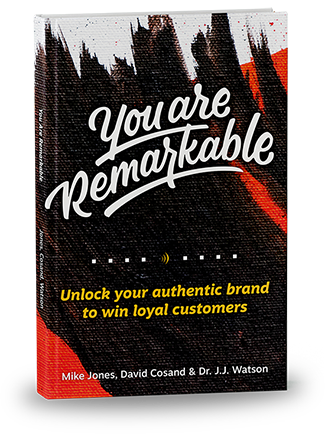Thought leadership makes you the expert. It establishes authority, credibility and influence in your industry. It transcends simply sharing information to position yourself and your brand as the trusted expert. Implement these key elements and actionable strategies to build effective thought leadership:
Change How They Think: Develop Content
Are you frustrated watching companies repeat the same mistakes? Good. If you are, and you can talk about it, that’s content.
In other words, get frustrated by things that hurt your clients, and then talk about it with them.
In our business, we wish companies would see the trust created by branding and thought leadership. To us, it’s easy to do. So why isn’t everyone either doing it or asking for our help? It’s simple: they just don’t see it like we do.
Thought leadership is your chance to help them think like you.
Here are some obvious and not-so-obvious ways to generate content. Which ones seem more relevant and doable to you?
- Blogs: These aren’t just about presenting information, but about helping them understand it the way you do.
- Podcasts: Do you like to talk more than write? Launch a podcast to interview other thought leaders and discuss topics prospective clients would be interested in. Promote across channels to build a dedicated audience. Bonus points if you invite guests (guests who have their own following) to expand your reach.
- Guest Posts: Contribute articles to well-known industry publications. Make sure you’re writing compelling pitches to capture editors’ attention.
- Reports and White Papers: Create and publish reports on original research (if you’re into that), case studies, or industry forecasts. Bonus points if you gate them behind a lead form to capture email addresses.
- Videos: Script and create engaging video content like explainer videos, interviews, webinars or documentaries. Optimize them for YouTube search to attract organic views.
- Speaking Engagements: Apply to speak at major industry conferences, events, and webinars to demonstrate your expertise on stage. Bonus points if you promote it on social media to maximize impact and reach.
Teaching Your Market to Think Like You
Thought leadership isn’t just about sharing knowledge. The goal is to get your audience to internalize and adopt your unique philosophy and framework. You want to train them to approach problems the way you do. Consider these examples:
-
Own a phrase. Drift: Drift introduced and popularized the concept of “conversational marketing”, which focuses on using real-time chat to engage prospects. Through publishing books, videos, and courses, they shifted people into this new paradigm and away from traditional lead capture forms. They show how coining a term can catalyze thought leadership.
-
Share your process. Moz: Moz transformed SEO from a shady tactic to a respectable marketing channel. By extensively teaching white-hat SEO through their blog, tools, and “Whiteboard Friday” video series, they redefined SEO as being about quality content and honest practices. Moz demonstrates how consistent education shapes an industry.
-
Spread your ethos. Basecamp: Basecamp holds strong philosophies about workplace culture, remote work, and staying intentionally small as a company. Books like “Rework” and “Remote”, along with their popular blog, influenced a generation of startup founders to embrace this ethos. Basecamp shows how thought leadership can flow from company values.
So how do you follow these examples? Admittedly, these examples show people who have thought about their topics a lot. That’s probably why they’re so hard to compete with (and why you should consider making that investment). You need to codify your philosophy into memorable concepts, frameworks, and signature language that people can easily grasp and adopt.
The more people think like you, the more they will look to you as the leader in your space.
A Long-Term Strategy for Thought Leadership
Let’s talk about strategy. Worth it or not? I mean, can’t you just wing it each month?
To get to that answers, let me ask you, what’s easier:
- Decide to publish monthly, but don’t create a process or timelines or a content calendar. Or
- Decide to publish monthly, but create your content calendar and monthly tempo in advance, so you don’t have to get reinspired?
For me, with all the things I have to deal with, the second one is easier.
Because at the beginning, I’m excited. I have all kinds of ideas. A month later, not so much.
Plus, I’m always thinking. I don’t need more. If I have my way, I’d like to make the decision once and then just follow the process, fine tuning as I go.
That’s why we make simple plans and then follow them every month, giving you consistency and making your commitment a lot less cumbersome. It’s a marathon, not a sprint.
So what does that look like? Here’s an example of a 1-year strategic roadmap:
Q1: Lay The Foundation
Some examples of how you might lay a foundation.
- Write and publish an in-depth blog posts per month to build your content foundation
- Plan and launch an interview-based podcast with an initial 10 episodes in the queue
- Create a gated white paper or report to capture email subscribers
But bite off only as much as you can chew. No need to go crazy and then burn out.
Q2: Expand Reach
Some examples of how to talk to people not already in your circle (and bring them in).
- Pitch 10 relevant industry blogs and contribute guest posts to build backlinks and authority
- Launch a weekly email newsletter to nurture and engage new subscribers
- Apply to speak at 5 major conferences and events to build personal connections
Q3: Deepen Engagement
Add some value.
- Survey your audience and publish a comprehensive “State of the Industry” report
- Create and launch a 5-part video course teaching your core philosophy and methods
- Plan and host a virtual summit featuring 20 expert speakers to grow your email list
- Offer 1:1 coaching or group workshops to provide hands-on help
- Organize a local chapter or meetup group to connect with customers face-to-face
Q4: Cement Authority
Now that you’ve been publishing, your philosophy should be coming together and firming up. You’re developing how you talk about your topic so people are starting to recognize your point of view.
- Write and publish a book that details your core philosophy and approach
- Create and launch a certification program to let others officially learn and use your methods
- Pitch and get featured on 10 industry podcasts as the expert guest
- Create a PR campaign to earn coverage in at least 5 mainstream media outlets
- Launch a small private community for your top customers/fans to foster deeper loyalty
Thought Leadership + Business Development
As we wrap up, consider that thought leadership builds power over time. It works WITH, not INSTEAD OF, business development. This means you’re still developing those relationships, going to conferences, and showing up to those networking events. This gives you good short-term clients. Then let them see how you think as you spread your ideas using the long-term strategy outlined here. Stay persistent in being genuinely helpful and people will increasingly see you as a trusted leader in your space. And if you need some help shaping your authentic message, we’d love to help!



